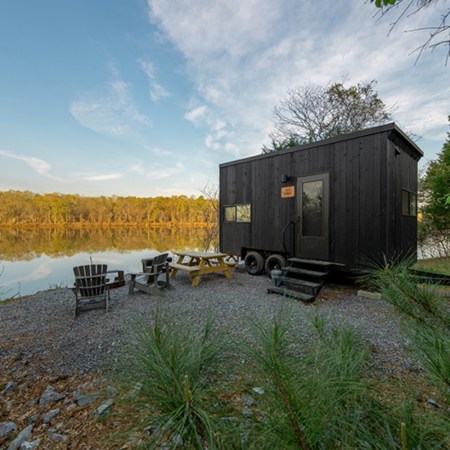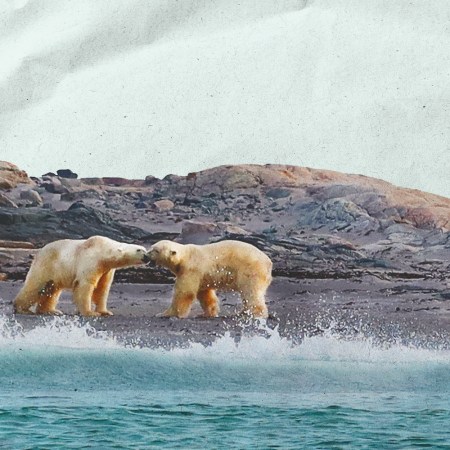There’s something uniquely mesmerizing about catching a sunset over the Grand Canyon or witnessing Old Faithful erupt skyward. Yosemite’s Half Dome is fully as awe-inspiring as you’ve always imagined, and Zion is just as otherworldly as it sounds. But as majestic as America’s national parks are, the quiet beauty of it all is somewhat deafened by trails so over-trafficked that you could crowd-surf to the summit. Nothing against these aforementioned parks, by any means — they’re rampant popularity is well-earned and bucket list-worthy. But at certain times of year, serenity doesn’t really go hand-in-hand with popularity.
As someone who thrives in the solitude of nature, the more underrated national parks have always been sanctuaries. Fortunately, with 63 formal national parks to visit, there are plenty of other options that conjure the same awe, minus the hordes that make trailheads look like a stop on The Eras Tour. With a comparable modicum of visitation, these lesser-known parks offer oases of natural beauty and trails that — often — you’ll have all to yourself. From Texas’s tallest peak to a swampy wonderland in the Lowcountry and a dormant volcano in California, these are 10 of the most underrated hikes in America’s national parks.

Guadalupe Peak, Guadalupe Mountains National Park
From the size of its steaks to the brims of its cowboy hats, it’s true that many things are indeed bigger in Texas — except for the visitation numbers at its national parks. Big Bend and Guadalupe Mountains are both are extremely remote and quiet, and the latter is particularly peaceful. Visitation peaked a few years ago when 243,000 people came to Guadalupe Mountains in 2021, which may sound like a lot, until you compare it to Yosemite’s 3.5 million, the Grand Canyon’s five million or the Great Smoky Mountains’ 13-plus million. What this West Texas park lacks in crowd size, though, it makes up for in elevation. Its namesake Guadalupe Peak is the tallest in the state, rising 8,751-feet above sea level, accessible via a strenuous 8.5-mile roundtrip trail that summits above the clouds. En route, hardcore hikers are met with 3,000 feet of elevation gain as they zigzag along its endless switchbacks, the valley below growing ever further. I’ve hiked this trail three times, and the endurance exercise is always rewardingly epic, culminating with panoramic views of the vast Texas desert on all sides. No matter how chilly it gets up there, be sure to always bring plenty of water, trail snacks and sunscreen.

Hot Springs Mountain, Hot Springs National Park
Nicknamed “Spa City” and once frequented by Hernando de Soto, Babe Ruth and Al Capone, Hot Springs isn’t exactly the kind of national park that sings of all-natural tranquility. But this Arkansas icon, an unabashedly weird utopia in the Ouachitas where history runs as deep as its famed thermal waters, is full of surprises. Technically pre-dating the world’s first national park, Hot Springs was given federal protection by President Andrew Jackson in 1832, a full 40 years before Yellowstone and 84 years before the National Park Service was formalized. Today, the offbeat park is mostly known for its indoor activities, like traditional thermal baths along Bathhouse Row. But right behind that lavish row of Renaissance Revival architecture, Hot Springs Mountain is the hiking trail you never knew you needed. Directly accessible from the Grand Promenade along Bathhouse Row, the moderate trail rises to less than 1,000-feet in elevation, which is just enough to provide sweeping views of the “Valley of the Vapors” down yonder. For an even better vista, ride an elevator to the top of Hot Springs Mountain Tower, where an open-air platform adds another 216-feet to the scenery.

Cactus Forest, Saguaro National Park
You know a trail is good when, despite literally getting hit by a car while riding my scooter to the park, I still insisted on hiking it. Maybe not my best decision, but it says a lot about the Cactus Forest Trail in Arizona’s Saguaro National Park. One of my most visited national parks and one that kept me company during the earliest throes of the pandemic, Saguaro National Park offers the kind of definitional solitude I so desperately sought. To my physical detriment, after ricocheting off a vehicle on the ride over, I dusted myself off and continued on my merry way with only a toe injury to show for it. Located on the east side of the park, where I’ve encountered more gila monsters than people, the Cactus Forest Trail has long been a haven for me — a relatively easy, flat trail that weaves through sky-scraping saguaro cacti for about 10 miles out-and-back. The little-hiked trail, both because of its flatness and its intimidating length under the ruthless Sonoran sun, has become such a familiar fixture of mine that there’s one soaring cacti in particular I’ve come to recognize and photograph each time. I even printed out the image and turned it into a custom puzzle, which I have framed on our guest room wall. Suffice to say, that trail really leaves a significant impression.

Petrified Forest Loop, Theodore Roosevelt National Park
Hot tip: if it’s solitude you’re after, North Dakota is always a safe bet. Which is precisely what first drew me to Theodore Roosevelt National Park, the only park named after a person and a setting of such vast beauty, it inspired its namesake to establish the National Park Service to begin with. Divvied into northern and southern units in western North Dakota, the sparsely visited park is teeming with trails that are as quiet as they are shockingly scenic. Like the Petrified Forest, a 10-mile loop in an especially remote portion of the south unit, where, according to my personal experience, wild horses outnumber hikers three to one. In addition to untamed equines, the (mostly) flat trail traverses billowing grasslands, gnarly badlands and boulder-sized petrified logs, most of which aren’t nearly as terrifying as they sound. Instead, it’s beauty at its most understated, and the kind of modest majesty that can enthrall presidents, hikers and horses alike.
Finding Solitude in National Parks Helped Me Evolve as a Traveler
How a fateful trip to Badlands National Park changed everything
Boardwalk Loop, Congaree National Park
To the untrained eye, Congaree National Park might look like some sort of dystopian jungle, with trees so imposingly tall that they block out the sun across a floodplain so immense it feels almost dooming. But it’s all part of a healthy, thriving ecosystem for one of America’s smallest national parks, where the namesake Congaree River routinely overflows to provide needed nourishment for those deeply rooted gentle giants. At just 26,000 acres, South Carolina’s Congaree is as diminutive in size as it is in visitorship, but don’t be misled by its meager mileage, flat trails or unexpected location mere minutes from the state capitol of Columbia. While kayaking and canoeing are the main attractions here, the park’s 2.6-mile Boardwalk Loop offers a singularly stunning foray into a forest of the tallest and largest trees east of the Mississippi. Thanks to its raised platform, it’s the one trail that’s pretty much always accessible, even when the park floods throughout the year.

Delta Lake, Grand Teton National Park
For about three quarters of the ascent up towards Delta Lake, in the shadows of Wyoming’s perpetually snow-capped Grand Tetons, you might see other hikers — you might even see bears or moose. Once you veer off from the main Amphitheater Lake Trail, however, things get decidedly more off-book. After departing from the same Lupine Meadows trailhead begins a long series of hairpin turns before finishing at a lake so turquoise and so tranquil, you’d swear you teleported to a galaxy far, far away. In fact, you’re only about seven miles from your car. The first three miles can get crowded in the summer and early fall, but Delta Lake is an unmaintained, unmarked trail that climbs through the backcountry, including a particularly rocky finale towards the end, which entails a bit of hands-on scrambling. Be mindful because even during the height of summer, it can be icy and cold, and a backup pair of gloves is helpful to carry in case you need to use your hands to grip rocks. The utter stillness of the lake, in all its ethereal glory, is well worth the extra effort.

Blue Mesa, Petrified Forest National Park
Once upon a time, Petrified Forest National Park was a subtropical realm of towering conifers and frankly terrifying dinosaurs that roamed during the Late Triassic Epoch. Some 225 million years later, those trees have long since fallen and those giant crocodilians have been reduced to nightmare-fueling fossils. More recently, the Arizona park — now a sprawling desert devoid of vegetation — was bisected by Route 66 and used as source material for Pixar’s Cars. How’s that for whiplash? Home to more than 200,000 acres, Petrified Forest is largely experienced as a drive-through park, thanks to its highway-adjacent locale, lack of hiking trails and the convenient fact that a 28-mile scenic drive meanders directly through it with quick access to stopovers like the Painted Desert and Giant Logs Loop. Of the few trails here, Blue Mesa is one that’s worth pulling over for. At just one mile, it’s short and simple, but proof that quality trumps quantity, as the paved trek descends off a mesa-top down into a canyon of blue-tinted badlands strewn with remnants of massive petrified logs. The sheer size of said logs, some of which out-size smart cars, is staggering enough, coupled with the twinkling tints of purple and green, imbued by minerals like manganese and iron that slowly — over the course of millions of years — petrified the wood into glistening stones.

Alkali Flat, White Sands National Park
If you truly want to imagine that you’re hiking on the planet Tatooine, make your way to one of America’s more recently designated national parks: White Sands. Located in southern New Mexico and comprising a gypsum dune field so enormous that it’s visible from outer space (and likely Tatooine), the 176,000-acre desert dreamscape is as surreal as it is sandy. Considering its seemingly lifeless landscape and that there’s a thunderous missile site next door, you could be forgiven for thinking there is no hiking to be found here. But then you’d be remiss not to experience the Alkali Flat Trail, which, at five miles roundtrip, is the longest in the park. Here, on a trail denoted by black diamond markers, you’ll shimmy up shifting sands on your way to the edge of dried-up Lake Otero, an Ice Age-era behemoth that’s now known as Alkali Flat. Naturally, considering its remoteness and the fact that you’re in the middle of the literal desert, it’s vital to keep your eyes peeled for trail markers and to stay heavily hydrated and shielded from the sun as much as possible. That said, this is as close to real-life Tatooine as you’re likely to come.

Devils Garden, Arches National Park
Calling Arches National Park underrated would be hilariously ironic, considering the Utah park is so popular it’s featured on the state license plate and commands crowds so dense that ticketed timed entry is required, lest the park reach Disneyland-level attendance. That said, there’s a far-flung section of the park that draws considerably less crowds, perhaps because, with a name like Devils Garden, it sounds daunting. It’s located at the furthest terminus of the main park road, well past the popular pull-offs for areas like Delicate Arch. And while you’ll still find plenty of other hikers along the way (this is still Arches, after all), it’s a more off-the-beaten-path alternative that promises its own rewards — including Landscape Arch, the longest of its kind on the continent. The entire Devils Garden Trail spans eight miles of narrow canyons and cliffs, offering a more strenuous scramble than the rest of the park’s shorter trails. For those willing to make the drive and the hike, the eerily-dubbed trail is a geologic showcase of high desert beauty.

Lassen Peak, Lassen Volcanic National Park
As you’re climbing Mount Lassen, the namesake peak in California’s least visited national park, take solace in knowing this plug dome volcano hasn’t erupted since 1915. Rising 10,457-feet over the Southern Cascades, it’s the world’s largest dome volcano with such high elevation. But there really isn’t any lava to worry about when summiting this dormant giant — just a daunting amount of switchbacks. The five-miler is well worth the haul, as the perpetually snowy peak feels like resting on the ceiling of Northern California, overlooking shimmering lakes, lush valleys and distant mountains for hundreds of miles. All the while, you’ll hike past rocky remnants from that last eruption more than a century ago.
This article was featured in the InsideHook newsletter. Sign up now.

























